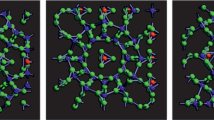Abstract
The thermal conductivity of methane hydrate is an important physical parameter affecting the processes of methane hydrate exploration, mining, gas hydrate storage and transportation as well as other applications. Equilibrium molecular dynamics simulations and the Green-Kubo method have been employed for systems from fully occupied to vacant occupied sI methane hydrate in order to estimate their thermal conductivity. The estimations were carried out at temperatures from 203.15 to 263.15 K and at pressures from 3 to 100 MPa. Potential models selected for water were TIP4P, TIP4P-Ew, TIP4P/2005, TIP4P-FQ and TIP4P/Ice. The effects of varying the ratio of the host and guest molecules and the external thermobaric conditions on the thermal conductivity of methane hydrate were studied. The results indicated that the thermal conductivity of methane hydrate is essentially determined by the cage framework which constitutes the hydrate lattice and the cage framework has only slightly higher thermal conductivity in the presence of the guest molecules. Inclusion of more guest molecules in the cage improves the thermal conductivity of methane hydrate. It is also revealed that the thermal conductivity of the sI hydrate shows a similar variation with temperature. Pressure also has an effect on the thermal conductivity, particularly at higher pressures. As the pressure increases, slightly higher thermal conductivities result. Changes in density have little impact on the thermal conductivity of methane hydrate.
Similar content being viewed by others
References
Cook JG, Laubitz MJ. The thermal conductivity of two clathrate hydrates. In: Proceedings of 17th International Thermal Conductivity Conference. Gaithersburg: Maryland Plenum, 1981: 13–40
Waite WF, Pinkston J, Kirby SH. Preliminary laboratory thermal conductivity measurements in pure methane hydrate and methane hydrate-sediment mixtures. In: A Progress Report, Proceedings of the Fourth International Conference on Gas Hydrate. Yokohama: Yokohama Symposia, 2002a: 728–733
Huang DZ, Fan SS. Thermal conductivity of methane hydrate formed from sodium dodecyl sulfate solution. J Chem Eng Data, 2004, 49: 1479–1482
Rosenbaum EJ, English NJ, Johnson JK, Shaw DW, Warzinski RP. Thermal conductivity of methane hydrate from experiment and molecular simulation. J Phys Chem B, 2007, 111: 13194–13250
Stoll RD, Bryan GM. Physical properties of sediments containing gas hydrates. J Geophys Res, 1979, 84: 1629–1634
Yue YJ, Ye YG, Diao SB, Zhao GT. Preliminary experiment on thermal properties of the sediments containing gas hydrate(in Chinese). Mar Geol Lett, 2007, 23: 35–37
Li DL. Acoustic characteristic and thermal properties of gas hydrate (in Chinese). Dissertation for the Doctoral Degree. Guangzhou: Guangzhou Institute of Energy Conversion, 2010. 90–93
Cook JG, Leaist DG. An exploratory study of the thermal conductivity of methane hydrate. Geophys Res Lett, 1983, 10: 397–399
Tse JS, White MA. Origin of glassy crystalline behavior in the thermal properties of clathrate hydrates: A thermal conductivity study of tetrahydrofuran hydrate. J Phys Chem, 1988, 92: 5006–5011
Schober H, Itoh H, Klapproth A, Chihaia V, Kuhs WF. Guest-host coupling and anharmonicity in clathrate hydrates. Eur Phys J E, 2003, 12: 41–50
Tse JS, Klein ML. Dynamical properties of the structure II hydrate of krypton. J Phys Chem, 1987, 91: 5789–5791
Dharma-wardana MWC. The thermal conductivity of the ice polymorphs and the ice clathrates. J Phys Chem, 1983, 87: 4185–4190
Kiefte H, Clouter MJ, Gagnon RE. Determination of acoustic velocities of clathrate hydrates by Brillouin spectroscopy. J Phys Chem, 1985, 89: 3103–3108
English NJ. Effects of electrostatics techniques on the estimation of thermal conductivity via equilibrium molecular dynamics simulation: Application to methane hydrates. Mol Phys, 2008, 106: 1887–1898
Jiang H, Myshakin EM, Jordan KD, Warzinski RP. Molecular dynamics simulations of the thermal conductivity of methane hydrate. J Phys Chem B, 2008, 112: 10207–10216
Vogelsang R, Hoheisel C. Thermal conductivity of a binary-liquid mixture studies by molecular dynamics with the use of Lennard-Jones potentials. Phys Rev A, 1987, 35: 3487–3491
Mahoney MW, Jorgensen WL. A five-site model for liquid water and the reproduction of the density anomaly by rigid nonpolarizable potential functions. J Chem Phys, 2000, 112: 8910–8922
Horn HW, Swope WC, Pitera JW, Madura JD, Dick TJ, Hura GL, Gordon TH. Development of an improved four-site water model for biomolecular simulations: TIP4P-Ew. J Chem Phys, 2004, 120: 9665–9678
Rick SW. Simulation of ice and liquid water over a range of temperatures using the fluctuating charge model. J Chem Phys, 2001, 114: 2276–2283
Abascal JLF, Sanz E, García Fernández R, Vega C. A potential model for the study of ices and amorphous water: TIP4P/Ice. J Chem Phys, 2005, 122:234511–234519
Abascal JLF, Vega C. A general purpose model for the condensed phases of water: TIP4P/2005. J Chem Phys, 2005, 123: 234505–12
Jorgensen WL, Madura JD, Swenson CJ. Optimized intermolecular potential functions for liquid hydrocarbons. J Am Chem Soc, 1984, 106: 6638–6646
Kirchner MT, Boese R, Billups WE, Norman LR. Gas hydrate single-crystal structure analysis. J Am Chem Soc,2004, 126: 9407–9412
Chelling PK, Phillpot SR, Keblinski P. Comparison of atomic-level simulation methods for computing thermal conductivity. Phys Rev B, 2002, 65: 144306–144318
Rapaport DC. The Art of Molecular Dynamics Simulation. 2nd ed. New York: Cambridge University Press, 2004. 124–128
Fan SS. Natural Gas Storage and Transportation in Hydrate Form (in Chinese). Beijing: Chemistry Engineer Press, 2005. 11
Ross RG, Andersson P, Bäckström G. Unusual PT dependence of thermal conductivity for clathrate hydrate. Nature, 1981, 290: 322–323
Hester KC, Dunk RM, White SN, Brewer PG, Peltzer ET, Sloan ED. Gas hydrate measurements at hydrate ridge using Raman spectroscopy. Geochim Cosmochim Acta, 2007: 2947-2959
Stern LA, Kirby SH, Durham WB. Peculiarities of methane clathrate hydrate formation and solid-state deformation including possible superheating of water ice superheating of water ice. Science, 1996, 273: 1843–1848
Author information
Authors and Affiliations
Corresponding author
Rights and permissions
About this article
Cite this article
Wan, L., Liang, D., Wu, N. et al. Molecular dynamics simulations of the mechanisms of thermal conduction in methane hydrates. Sci. China Chem. 55, 167–174 (2012). https://doi.org/10.1007/s11426-011-4473-x
Received:
Accepted:
Published:
Issue Date:
DOI: https://doi.org/10.1007/s11426-011-4473-x




